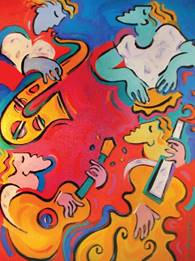 Granted, I’m biased. I love this image painted by Colin Righton as the logo for Jazzthink, my consulting and coaching company, back in 2002. It’s rich in imagery and in possibilities for drawing out lessons from jazz for nonprofit flourishing. What I want to focus on in this article is the importance of everyone playing the same melody line as you help people change their lives for the better.
Granted, I’m biased. I love this image painted by Colin Righton as the logo for Jazzthink, my consulting and coaching company, back in 2002. It’s rich in imagery and in possibilities for drawing out lessons from jazz for nonprofit flourishing. What I want to focus on in this article is the importance of everyone playing the same melody line as you help people change their lives for the better.
Jazz musicians play from scores that have very few notes. They are called chord charts. I’ve refined that to “core” charts. Imagine the melody line to Bob Marley’s “One Love” in that red space at the center of the painting.
That’s what these four are playing. Hum along in your head – “One love, one heart/Let’s get together and feel all right!”
Is Your Vision Statement Clear, Concise, and Comprehensible?
I’m constantly surprised by leaders in organizations dismissing the importance of a clear, concise, and comprehensible vision statement as an essential tool for coordinating collaboration.
It should be lucid, illuminating the core purpose the organization serves. It should be short – fifteen words max, preferably fewer. And it should be made up of words that are loaded with value and feeling.
That’s what makes them understandable and sticky. You can remember them easily. They can refocus and align your hearts and heads quickly in the midst of distractions and disputes.
Does Your Vision Statement Have a Melody Line?
Think of a melody line. Are you still humming “One Love?” That’s what a good vision statement is. It keeps you humming along together. Here are some examples from organizations I’ve worked with.
Nourishing souls to flourish in the grace of Jesus Christ
Being influential leaders
Healthy and affordable community living for seniors
Helping people, changing lives, building community
We nurture respect and collaboration to create meaningful lives and work
Some organizations had them already. Some composed them as we worked together. All tested them out over a considerable period of time in a variety of situations to ensure that they helped to shape the cohesive culture all those organizations wanted to nurture.
What this kind of clarity provides is a compelling centre for all your efforts to serve your constituencies, be they customers (Peter Drucker’s word for those we often call clients), staff, board members, funders, and community allies.
Now you can create space for big ideas and big personalities. You can create space to be creative with strategic and generative ideas for improvements. You can handle differences in strengths, talents, temperaments, and opinions. Because at the centre of that space is the melody everyone has agreed to play. The defining questions have shifted from “What are we all about here?” to “How can we best achieve our core purpose?”
Jamaican-born pianist Monty Alexander said in the liner notes for Impressions in Blue (2003), “Jazz, at its best, is a situation in which participants willingly support each other, working together as one, each musician bringing virtuosity, optimism, mutual respect, good will, and the desire to make it feel good.” If you are constantly wondering what melody you’re playing together, then none of this happens. Every now and then, you might be lucky enough to be in sync for a little while, but the overall performance is all over the place.
If that sounds like your nonprofit these days, then get up into the balcony with your whole organization and figure out your core vision. Compose it as a melody line that everyone knows and loves. Orient everyone who comes into the organization to contribute their creative and passionate best to that melody/vision/purpose.
It sounds simple and it is. Here’s one way to do that composing that has worked well for organizations I’ve assisted. Ask as many people as possible what they value most about what your organization offers to the community. Transcribe their answers verbatim and circulate that raw data. Invite the most engaged people to identify the ten most powerful words or phrases found in those answers. Do that again to refine it even further. Out of those words, draft a number of vision statements. Combine and refine until one ‘melody line’ stands out as the most compelling. Test that version for three months, using it to structure meetings, do staff and board training, resolve conflicts, attract funding and support, coordinate volunteers, and, above all, serve your customers. Refine it as needed, then keep reviewing and refining it every year or so.
Think again about the red energy in the centre of Colin’s painting. Think what would give it the most beneficial power if your organization was a jazz group (which it is, by the way). I suspect that you will come up with something like a melody line that is clear, concise, and comprehensible.
This article is Copyright 2018 CharityChannel LLC. It was originally published by CharityChannel at https://charitychannel.com/vision-statement-melody.
You can find Brian’s CharityChannel biography at: https://charitychannel.com/contributor/brian-fraser/
